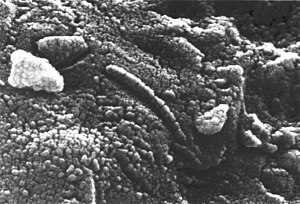I was sitting at my desk when the Instant Messenger window opened up. It was Dave Brody. He had been our executive producer at SciFi when I hosted Inside Space.
Dave was excited about an announcement that had been made and exclusively reported by space.com, where he now works:
Washington — A pair of NASA scientists told a group of space officials at a private meeting here Sunday that they have found strong evidence that life may exist today on Mars, hidden away in caves and sustained by pockets of water.
Here’s the full space.com story if you’re interested. Dave and I have been through similar announcements before; specifically the Allen Hills Meteorite ALH84001¹.
It is because of Dave that I actually got to hold that meteorite, safely sealed in a controlled environment, through a port in my rubber gloved hands
It would be astounding if life were actually found today, living on Mars. But hold on. To quote George Harrison, “What Is Life?” What these scientists consider life and what you and I probably think of when we hear the word are totally different.
I typed something like that back to Dave, who replied with his best read on what the first extraterrestrial life discovered might be. “Pond scum. Extremeophile² Pond Scum.”
When scientists start talking about extraterrestrial life, they’re not talking about ET! They’re thinking about forms of life that I consider more chemistry that biology.
Still, Dave has a very important point that applies… even to the most rudimentary forms of life. “If it has our DNA, it means “they is us” (as Pogo once said).”
He’s right. I guess, that changes everything.
¹ – From Wikipedia – A 4500-million-year-old meteorite found in the Allen Hills of Antarctica (ALH84001). Ejection from Mars seems to have taken place about 16 million years ago. Arrival on Earth was about 13000 years ago. Cracks in the rock appear to have filled with carbonate materials between 4000 and 3600 million years ago. Evidence of polycyclic aromatic hydrocarbons (PAHs) have been identified with the levels increasing away from the surface. Other antarctic meteorites do not contain PAHs. Earthly contamination should presumably be highest at the surface. Several minerals in the crack fill are deposited in phases, specifically, iron deposited as magnetite, that are claimed to be typical of biodepositation on Earth. There are also small ovoid and tubular structures that might possibly be nanobacteria fossils in carbonate material in crack fills (investigators McKay, Gibson, Thomas-Keprta, Zare). Micropaleontologist Schopf, who described several important terrestrial bacterial assemblages, examined ALH84001 and opined that the structures are too small to be Earthly bacteria and don’t look especially like lifeforms to him. The size of the objects is consistent with Earthly “nanobacteria”, but the existence of nanobacteria itself is controversial.
² – Extremeophile seems to be an alternate spelling for extremophile.
An extremophile is an organism, usually unicellular, which thrives in or requires “extreme” conditions. The definition of “extreme” is anthropocentric, of course. To the organism itself its environment is completely normal. Non-extremophilic organisms are called mesophiles.
 An eclipse takes place late Monday night, my time. That’s early Tuesday morning back on the East Coast.
An eclipse takes place late Monday night, my time. That’s early Tuesday morning back on the East Coast. Only in a tiny region of Antarctica will see the full annular eclipse. There it happens with the Sun on the horizon for just 49 seconds!
Only in a tiny region of Antarctica will see the full annular eclipse. There it happens with the Sun on the horizon for just 49 seconds!
 Back when I was hosting Inside Space, this was one of my most interesting shoots. I took a day off from work in Connecticut, hopped a Continental flight to Houston and headed to NASA in Clear Lake. Instead of the usual visit to see ‘manned spaceflight’ experts (NASA JSC’s expertise), we went to see Dr. David McKay in his well equipped laboratory.
Back when I was hosting Inside Space, this was one of my most interesting shoots. I took a day off from work in Connecticut, hopped a Continental flight to Houston and headed to NASA in Clear Lake. Instead of the usual visit to see ‘manned spaceflight’ experts (NASA JSC’s expertise), we went to see Dr. David McKay in his well equipped laboratory. Helaine and I have just returned from the movies where we saw March of the Penguins. It is a French documentary on the life cycle of the Emperor Penguin, which lives in and around Antarctica.
Helaine and I have just returned from the movies where we saw March of the Penguins. It is a French documentary on the life cycle of the Emperor Penguin, which lives in and around Antarctica. Much of the wintertime footage was shot in howling winds and blowing snow. As far as I can see, the severity of the weather was actually played down. You could have accentuated the environment’s wrath, but instead, natural sound was kept to a minimum.
Much of the wintertime footage was shot in howling winds and blowing snow. As far as I can see, the severity of the weather was actually played down. You could have accentuated the environment’s wrath, but instead, natural sound was kept to a minimum.